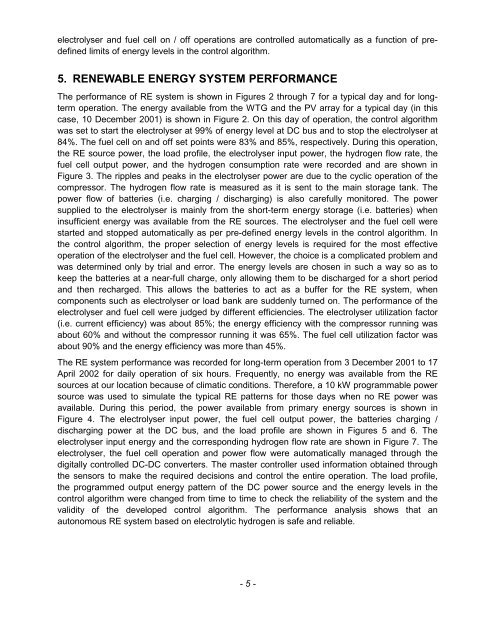stand-alone renewable energy system based on hydrogen production
stand-alone renewable energy system based on hydrogen production stand-alone renewable energy system based on hydrogen production
We studied the electrolyser and the fuel cell polarization characteristics, which depend mainly on voltage, current and temperature. Sensors were used to record real-time voltages and currents of WTG, PV array, DC bus / battery, electrolyser, fuel cell, load, hydrogen detectors, electrolytic hydrogen flow rate from the electrolyser, hydrogen consumption rate in the fuel cell, oxidant consumption rate in the fuel cell, hydrogen and oxidant pressure in the fuel cell, fuel cell stack temperature, electrolyser cell temperature, DC-DC converter (boost and buck) duty ratio. Additional sensors in the electrolyser and the fuel cell
electrolyser and fuel cell on / off operations are controlled automatically as a function of predefined limits of
- Page 1 and 2: STAND-ALONE RENEWABLE ENERGY SYSTEM
- Page 3: RE system componen
- Page 7 and 8: 5000 4000 Power from Primary Source
- Page 9: 6. CONCLUSIONS The successful long-
electrolyser and fuel cell <strong>on</strong> / off operati<strong>on</strong>s are c<strong>on</strong>trolled automatically as a functi<strong>on</strong> of predefined<br />
limits of <str<strong>on</strong>g>energy</str<strong>on</strong>g> levels in the c<strong>on</strong>trol algorithm.<br />
5. RENEWABLE ENERGY SYSTEM PERFORMANCE<br />
The performance of RE <str<strong>on</strong>g>system</str<strong>on</strong>g> is shown in Figures 2 through 7 for a typical day and for l<strong>on</strong>gterm<br />
operati<strong>on</strong>. The <str<strong>on</strong>g>energy</str<strong>on</strong>g> available from the WTG and the PV array for a typical day (in this<br />
case, 10 December 2001) is shown in Figure 2. On this day of operati<strong>on</strong>, the c<strong>on</strong>trol algorithm<br />
was set to start the electrolyser at 99% of <str<strong>on</strong>g>energy</str<strong>on</strong>g> level at DC bus and to stop the electrolyser at<br />
84%. The fuel cell <strong>on</strong> and off set points were 83% and 85%, respectively. During this operati<strong>on</strong>,<br />
the RE source power, the load profile, the electrolyser input power, the <strong>hydrogen</strong> flow rate, the<br />
fuel cell output power, and the <strong>hydrogen</strong> c<strong>on</strong>sumpti<strong>on</strong> rate were recorded and are shown in<br />
Figure 3. The ripples and peaks in the electrolyser power are due to the cyclic operati<strong>on</strong> of the<br />
compressor. The <strong>hydrogen</strong> flow rate is measured as it is sent to the main storage tank. The<br />
power flow of batteries (i.e. charging / discharging) is also carefully m<strong>on</strong>itored. The power<br />
supplied to the electrolyser is mainly from the short-term <str<strong>on</strong>g>energy</str<strong>on</strong>g> storage (i.e. batteries) when<br />
insufficient <str<strong>on</strong>g>energy</str<strong>on</strong>g> was available from the RE sources. The electrolyser and the fuel cell were<br />
started and stopped automatically as per pre-defined <str<strong>on</strong>g>energy</str<strong>on</strong>g> levels in the c<strong>on</strong>trol algorithm. In<br />
the c<strong>on</strong>trol algorithm, the proper selecti<strong>on</strong> of <str<strong>on</strong>g>energy</str<strong>on</strong>g> levels is required for the most effective<br />
operati<strong>on</strong> of the electrolyser and the fuel cell. However, the choice is a complicated problem and<br />
was determined <strong>on</strong>ly by trial and error. The <str<strong>on</strong>g>energy</str<strong>on</strong>g> levels are chosen in such a way so as to<br />
keep the batteries at a near-full charge, <strong>on</strong>ly allowing them to be discharged for a short period<br />
and then recharged. This allows the batteries to act as a buffer for the RE <str<strong>on</strong>g>system</str<strong>on</strong>g>, when<br />
comp<strong>on</strong>ents such as electrolyser or load bank are suddenly turned <strong>on</strong>. The performance of the<br />
electrolyser and fuel cell were judged by different efficiencies. The electrolyser utilizati<strong>on</strong> factor<br />
(i.e. current efficiency) was about 85%; the <str<strong>on</strong>g>energy</str<strong>on</strong>g> efficiency with the compressor running was<br />
about 60% and without the compressor running it was 65%. The fuel cell utilizati<strong>on</strong> factor was<br />
about 90% and the <str<strong>on</strong>g>energy</str<strong>on</strong>g> efficiency was more than 45%.<br />
The RE <str<strong>on</strong>g>system</str<strong>on</strong>g> performance was recorded for l<strong>on</strong>g-term operati<strong>on</strong> from 3 December 2001 to 17<br />
April 2002 for daily operati<strong>on</strong> of six hours. Frequently, no <str<strong>on</strong>g>energy</str<strong>on</strong>g> was available from the RE<br />
sources at our locati<strong>on</strong> because of climatic c<strong>on</strong>diti<strong>on</strong>s. Therefore, a 10 kW programmable power<br />
source was used to simulate the typical RE patterns for those days when no RE power was<br />
available. During this period, the power available from primary <str<strong>on</strong>g>energy</str<strong>on</strong>g> sources is shown in<br />
Figure 4. The electrolyser input power, the fuel cell output power, the batteries charging /<br />
discharging power at the DC bus, and the load profile are shown in Figures 5 and 6. The<br />
electrolyser input <str<strong>on</strong>g>energy</str<strong>on</strong>g> and the corresp<strong>on</strong>ding <strong>hydrogen</strong> flow rate are shown in Figure 7. The<br />
electrolyser, the fuel cell operati<strong>on</strong> and power flow were automatically managed through the<br />
digitally c<strong>on</strong>trolled DC-DC c<strong>on</strong>verters. The master c<strong>on</strong>troller used informati<strong>on</strong> obtained through<br />
the sensors to make the required decisi<strong>on</strong>s and c<strong>on</strong>trol the entire operati<strong>on</strong>. The load profile,<br />
the programmed output <str<strong>on</strong>g>energy</str<strong>on</strong>g> pattern of the DC power source and the <str<strong>on</strong>g>energy</str<strong>on</strong>g> levels in the<br />
c<strong>on</strong>trol algorithm were changed from time to time to check the reliability of the <str<strong>on</strong>g>system</str<strong>on</strong>g> and the<br />
validity of the developed c<strong>on</strong>trol algorithm. The performance analysis shows that an<br />
aut<strong>on</strong>omous RE <str<strong>on</strong>g>system</str<strong>on</strong>g> <str<strong>on</strong>g>based</str<strong>on</strong>g> <strong>on</strong> electrolytic <strong>hydrogen</strong> is safe and reliable.<br />
- 5 -



